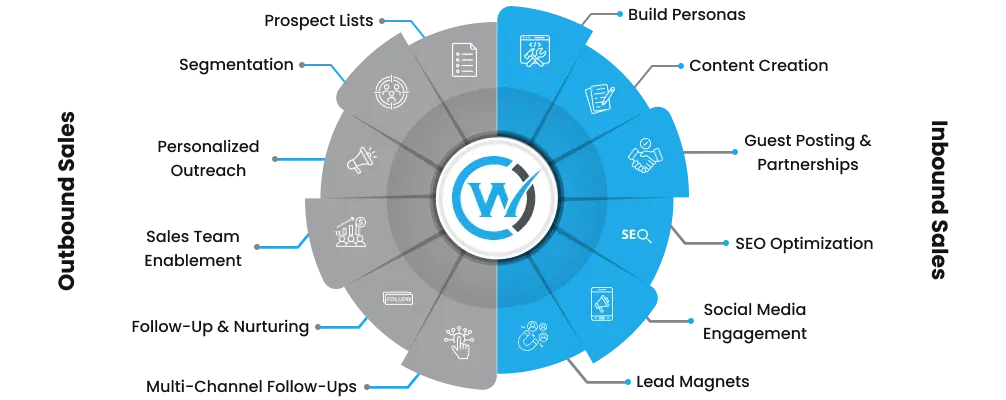

Are you ready to disrupt with AI? Join our Hackathon today! Click to Register
Table of Contents
ToggleWhether you’re a startup trying to get off the ground or an established business looking to scale new heights, one thing remains constant – the need for unstoppable lead generation. As a sales leader, you know that leads are the lifeblood of business growth. But are you leveraging the full power of inbound and outbound sales strategies to maximize your lead gen?
These two approaches, when integrated thoughtfully, form an unbeatable dynamic duo. Let’s dive in, to understand what makes inbound and outbound sales such a powerful combination for continuous lead generation.
Nope, we won’t give you the basic definitions and leave you wondering, because, we know you want more, to understand about these sales. Let’s understand inbound sales more than its definition, shall we?
Inbound sales revolve around attracting potential customers by creating valuable content and experiences. Instead of pushing your product outward, you pull customers in by addressing their needs and pain points. Tactics like content marketing, SEO optimization, and social media engagement help nurture prospects and convert them into marketing-qualified leads. The non-intrusive nature of inbound strategies builds trust and establishes your brand as a helpful thought leader.
On the other hand, outbound sales are all about targeted outreach to potential customers through mediums like email, cold calling, direct mail, and paid ads. While inbound strategies pull customers in, outbound tactics push your messaging outwards to grab attention. Outbound activities help create new conversations that inbound content alone cannot.
It’s clear how these two methodologies complement each other beautifully. Inbound activities attract and nurture, while outbound tactics stimulate action. Relying solely on inbound sales would mean leaving potential leads untapped if they’re not organically engaging with your content. Outbound-only strategies can struggle to convert leads without inbound nurturing. But together, these sales superheroes can achieve lead-generation feats that neither could on their own.

The numbers speak for themselves – combining inbound and outbound methodologies can supercharge lead generation. But how exactly can you integrate the two smoothly? Here are some tips:
1. Use content offers and lead magnets to collect prospect contact info for future outbound nurturing. Offer value first via inbound activities.
2. Segment your inbound leads based on engagement levels. Prioritize less engaged prospects for additional outbound nurturing.
3. Set reminders to follow up on promising inbound prospects who have gone cold using email or phone calls.
4. Use lead intelligence tools to identify ideal prospects for outbound campaigns if inbound traction is low. Go where your customers are.
5. Ensure messaging alignment across inbound and outbound activities to create a cohesive customer experience.
While inbound and outbound sales play off each other’s strengths, they do have some core differences:
1. Less intrusive, focusing on attraction and pull
2. Long-term brand and trust building
3. Lower cost per lead generated
4. Continuous nurturing throughout funnel
1. More interruptive, focusing on outreach and push
2. Short-term conversations and promotions
3. Higher cost per lead generated
4. Lead acceleration and conversion focused
Understanding these differences allows you to deploy the two approaches strategically based on your goals. For top-funnel awareness building, inbound takes the lead. When you need to hit quarterly lead targets, outbound helps seal the deal.

Now that we’ve explored the immense potential of combining inbound and outbound sales, let’s get tactical. Here is a step-by-step methodology to deploy this dynamic duo:
Master Inbound Sales
1. Build personas and map out your target audience’s buyer journey to create relevant content across the funnel. Identify their needs and pain points at each stage.
2. Produce blogs, visual assets, videos, guides, and other valuable educational content tailored to your audience’s interests. Promote content through owned channels.
3. Secure guest posting and partnership opportunities with publications and brands your audience follows. Expand your content distribution.
4. Optimize all assets and website pages for target keywords using on-page SEO and metadata best practices. Make it easy for your audience to discover your brand.
5. Leverage social media platforms like LinkedIn and Twitter to share content, engage followers, and join relevant conversations. Build communities.
6. Create and promote lead magnets like gated content, free tools, and webinars in exchange for prospect contact info. Offer value before the hard sell.

Execute Outbound Sales
1. Compile targeted prospect lists for outbound campaigns by tapping into your network, paid data sources, trade events, and LinkedIn Sales Navigator.
2. Segment prospects based on website activity, engagement with your inbound content, and lead score. Identify outbound-ready targets.
3. Craft highly personalized email sequences, call scripts, social media outreach cadences, and direct mailers tailored to prospect needs.
4. Equip sales teams to execute campaigns effectively. Set performance benchmarks and train them on best practices for outreach conversations. Track outbound KPIs.
5. Monitor prospect engagement with outbound action items and follow up accordingly. Continue nurturing promising leads through the funnel.
6. Use multi-channel follow-ups across email, phone, social media, and chat for higher response rates. Meet prospects where they prefer to engage.
Lean on the combined powers of inbound and outbound sales to keep your lead generation engine running nonstop. No single strategy can address all prospect needs – but together they’ve got all bases covered. To make this dynamic duo work for your business, partner with a B2B marketing agency that leverages the strengths of both inbound and outbound lead generation strategies. With the right integration, your sales will sprint towards growth and profitability. You can give a thought to this and strategies your sales to unleash the duo today!